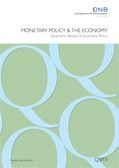Monetary Policy and the Economy Q2-Q3/23
 OeNB
OeNB
- published:
- December 2023
 OeNB
OeNB
Monetary Policy and the Economy Q2-Q3/23 (PDF, 4.8 MB) December 2023
Austria’s economy set to recover after period of stagflation. Economic outlook for Austria from 2023 to 2025 (June 2023) (PDF, 1.6 MB) Fritzer, Moser, Ragacs, Reiss, Stiglbauer, Vondra. en Dec 4, 2023, 12:00:00 AM
How have profits been shaping domestic price pressures in Austria? (PDF, 2.7 MB) Fritzer, Prammer, Reiss, Schneider. There is an ongoing debate as to whether profits have been driving inflation in Austria and in the euro area. We address this question by decomposing the value added deflator for the Austrian economy into its income components: compensation of employees, net operating surplus, consumption of fixed capital and taxes less subsidies on production. Furthermore, we conduct this decomposition not only for the economy as a whole but also for major sectors of the economy. In 2022, the value added deflator for the Austrian economy grew at a rate of 6.4%. Profits contributed 4.0 percentage points thereof, thus accounting for more than half of value added inflation. To assess whether profits have been driving up inflation disproportionately, we calculate the contribution of all income components on a balanced growth path, which leaves the income components’ impact on value added constant, and define any growth above this threshold as nonneutral or disproportionate. We thus see that in 2022 nonneutral profits explained more than one-third (2.5 percentage points) of domestic inflation. With respect to sectoral developments, energy (including water supply and waste management), construction and agriculture (including forestry) as well as financial and insurance activities contributed most to the growth of the value added deflator. In 2023 and 2024, the inflation contribution of profits will decline owing to the expected strong growth of unit labor costs and the increasing contribution of depreciation. Over the period from 2020 to 2024, the average nonneutral profit contribution to the growth of the value added deflator will be minor judging from the OeNB’s most recent macroeconomic projections. en domestic price pressure, profit share E31, D33 Dec 4, 2023, 12:00:00 AM
Energy price shock poses additional challenge to Austria’s price competitiveness (PDF, 1.3 MB) Glauninger, Url, Vondra. This article reports on the latest update of Austria’s effective exchange rate indices, which aggregate bilateral exchange rates and relative prices or costs into indicators of Austria’s short- to medium-term international competitive position. The weighting scheme on which the indicators are based uses bilateral trade data for Austria’s 55 most important trading partners. With the latest update, the three-year averaging period was moved forward to 2016-2018. The main results are as follows: Based on the recalculated country weights, we confirm the preliminary finding of a medium-term worsening of Austria’s competitive position, although alternative price indices would appear to provide conflicting signals. In particular, measures based on producer prices and unit labor costs indicate competitiveness gains, while the HICP/CPI-based index shows marked losses. These diverging signals, however, merely reflect data availability at the current edge. With regard to the geographical focus of Austria’s international trade relations, we observe a further shift toward overseas markets in the US dollar area and China, away from Western Europe and Russia. The real effective exchange rate for the tourism industry, which we developed during the previous update and enhanced during this update, reflects a more pronounced appreciation in the tourism sector than in the service sector as a whole. However, according to the latest figures on overnight stays this loss in price competitiveness has had no significant dampening effect on tourism demand in recent months. Finally, we address the economic costs of Austria’s current inflation differential to the euro area, which has induced a real appreciation. In two simulations, we quantify realized effects and calculate expected future losses driven by higher unit labor costs. In total, we find that the loss in price competitiveness may cause the Austrian economy to shrink by around ¾ to 1 percentage point between 2022 and 2025. en international competitiveness, effective exchange rate index, tourism services C43, F14, F47 Dec 4, 2023, 12:00:00 AM
Monetary policy in uncertain times: toward robustness and resilience. Key findings from the 50th OeNB Economics Conference and 60th SUERF Anniversary Conference (May 22 and 23, 2023).
(PDF, 466 kB)
Gnan, Klieber, Kwapil, Rieder, Rumler, Salish, Valderrama, Zörner.
When central banks of advanced economies conducted monetary policy strategy reviews in the early 2020s, they did so during a period characterized by a persistent undershooting of inflation targets. Thus, the key objective of the reviews was to explore ways of increasing the effectiveness of monetary policy in bringing inflation and inflation expectations back to target at the effective lower bound. Given that in 2021 the tides turned to a dramatic overshooting of inflation targets, the question arises whether the analyses made at the time were overly focused on a particular state of the world and failed to be adequately robust to accommodate the possibility of dramatically and fast-changing circumstances. The current environment is characterized by higher volatility and increased uncertainty about economic conditions and has shown how large and sudden shocks can sharply change economic and financial conditions in a matter of months, not only locally but also globally.
Marking the 50th anniversary of the OeNB’s Annual Economic Conference and SUERF’s 60th anniversary, the OeNB and SUERF jointly organized a two-day high-level research and policy conference, which was attended by 781 participants (315 at the Vienna Museumsquartier and 466 online). The conference explored avenues to render central banks’ strategies and analytical tools more robust and resilient to unexpected changes in the conditions under which they may need to operate; how to make monetary policy decisions robust and resilient to uncertain outcomes; the importance of interaction between fiscal policy and monetary policy and how to tailor central bank communication to high inflation and high uncertainty. Additionally, the conference presented research by a select group of young economists on inflation and the transmission of monetary policy.
en
Dec 4, 2023, 12:00:00 AM